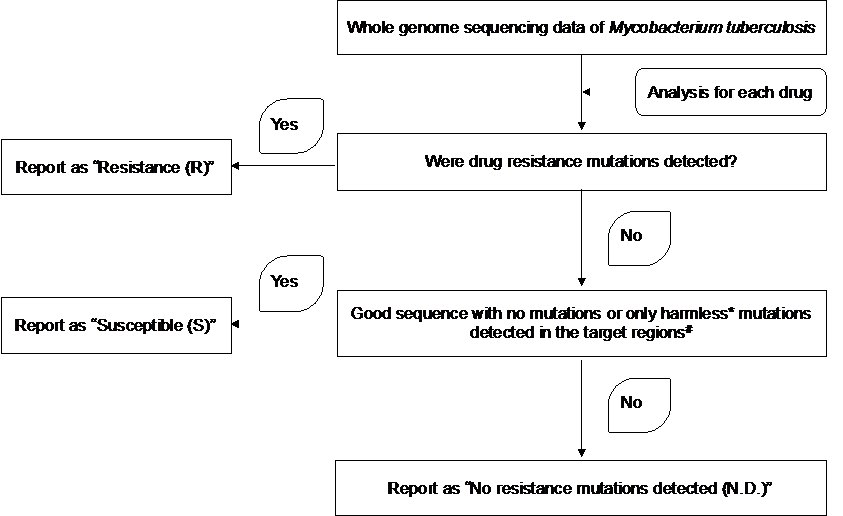SAM-TB
Home
My data
My analysis
My samples
Help
FAQ
中文
Sign in
##Prediction of susceptibility and resistance to first-line drugs ###The threshold of variant detection For the identification of resistance mutations, the variants should meet the following conditions: a minimum read depth of 5×, the frequency of the mutant allele is at least 10%, and the mutant allele is found on at least one read from each strand. ###Resistance mutation library of four first-line drugs (isoniazid, rifampicin, ethambutol, and pyrazinamide) The detection of drug resistance to isoniazid, rifampicin, ethambutol, and pyrazinamide is based on drug resistance mutations extracted from two publicly available publications [1,2]. In the merged resistance mutation library, the genes examined to detect: isoniazid resistance are *inhA*, *katG*, *ahpC*, *fabG1*, and *kasA*; rifampicin resistance are *rpoB* and *rpoC*; ethambutol resistance are *embA*, *embB*, and *embC*; and pyrazinamide resistance are *pncA*, *panD* and *rpsA*. ###The principle of prediction The prediction of susceptibility and resistance to the four first-line drugs is based on reference [1]. As shown in the figure, the prediction is based on the sequencing data and the library of drug resistance and harmless mutations. The results include “resistance”, “susceptible” and “No resistance mutation detected”.  Note: *The harmless mutations are believed to have no effect on resistance. #The target regions are the genes and promoter regions associated with resistance to the four first-line drugs, including *katG*, *inhA*, *fabG1*, *ahpC*, *rpoB*, *embA*, *embB*, *embC*, *pncA*. ###Applicability and limitations (1) Due to the limitations of the current technology and version of the database, the analysis results of the website can only be used as a reference for scientific research and should not be used as a clinical diagnostic standard. (2) The analysis results of the website can only be used as a reference for clinical treatment and should not be used as the basis for treatment. The website is not responsible for the consequences (including mental, physical, economic and legal aspects) caused by any actions taken by users based on the analysis results; (3) As our knowledge of resistance mechanisms grows, some drug resistance and harmless mutations in the library may change. The website will regularly update the mutation library in response to new evidence. ###Update Logs ##### 2024.04 In November 2023, the World Health Organization (WHO) released the second edition of the “Catalogue of mutations in Mycobacterium tuberculosis complex and their association with drug resistance”[3]. Based on this WHO catalogue, the drug-resistant mutations database of SAM-TB has been updated and expanded. Table 1 shows the drug resistance-related genes of four first-line drugs in the new version of the database, and Table 2 and 3 respectively show the number of adjusted drug-resistant and sensitive mutations in the new version of the database. Table 1: In the new version of the database, drug resistance-related genes of four first-line drugs |Drugs|Candidate drug resistance-related genes| |----|----| |Isoniazid|ahpC,fabG1,inhA,kasA,katG| |Rifampicin|rpoB,rpoC| |Pyrazinamide|pncA,panD,rpsA| |Ethambutol|embA,embB,embC,embR| Table 2: The number of adjusted drug-resistant mutations in the new version of the database |Drugs|No change|Down from High to Low|Up from sensitive to Low|Up from sensitive to High|Up from Low to High|New Low|New High| |----|----|----|----|----|----|----|----| |Isoniazid|329|2|-|-|3|20|2| |Rifampicin|7751|8|1|-|6|56|2| |Pyrazinamide|445|40|1|1|41|25|13| |Ethambutol|190|-|-|-|5|-|-| Note: In the new version of the database, the adjustments to the confidence of drug resistance mutations are as follows. - “No change”: The confidence level of the drug resistance mutation remains unchanged; - “Down from High to Low”: The confidence level of the drug resistance mutation is adjusted from “High-confidence” to “Low-confidence”; - “Up from sensitive to Low”: Mutations previously marked as “sensitive” are now adjusted to “Low-confidence” drug resistance mutations; - “Up from sensitive to High”: Mutations previously marked as “sensitive” are now adjusted to “High-confidence” drug resistance mutations; - “Up from Low to High”: The confidence level of the drug resistance mutation is increased from “Low-confidence” to “High-confidence”; - “New Low”: New “Low-confidence” drug resistance mutations; - “New High”: New “High-confidence” drug resistance mutations. Table 3: The number of adjusted drug-sensitive mutations in the new version of the database |Drugs|No change|Down from Low to sensitive|New sensitive| |----|----|----|----| |Isoniazid|1558|-|1225| |Rifampicin|1232|2|1415| |Pyrazinamide|214|3|614| |Ethambutol|3601|-|462| Note: In the new version of the database, the adjustments to the sensitivity of susceptible mutations are as follows. - “No change”: The sensitivity of the susceptible mutation remains unchanged; - “Down from Low to sensitive”: Mutations previously marked as “Low-confidence” drug resistance mutations are now adjusted to “susceptible” mutations; - “New sensitive”: New “susceptible” mutations. ###Reference [1] Walker TM, Kohl TA, Omar SV, Hedge J, Del Ojo Elias C, Bradley P, et al. Whole-genome sequencing for prediction of Mycobacterium tuberculosis drug susceptibility and resistance: a retrospective cohort study. The Lancet Infectious diseases. 2015;15(10):1193-202. doi: 10.1016/S1473-3099(15)00062-6. PubMed PMID: 26116186; PubMed Central PMCID: PMC4579482. [2] Jody E Phelan, Denise M O'Sullivan, Diana Machado, Jorge Ramos, Yaa E A Oppong, Susana Campino, Justin O'Grady, Ruth McNerney, Martin L Hibberd, Miguel Viveiros, Jim F Huggett, Taane G Clark. Integrating informatics tools and portable sequencing technology for rapid detection of resistance to anti-tuberculous drugs. Genome Med. 2019;11(1):41. doi: 10.1186/s13073-019-0650-x. PubMed PMID: 31234910; PubMed Central PMCID: PMC6591855. [3] WHO. Catalogue of mutations in Mycobacterium tuberculosis complex and their association with drug resistance, 2nd edn. 2023. https://www. who.int/publications/i/item/9789240082410.
<< Return
Title:
Description:
Thank you for using our service, we will reply you by email as soon as possible.